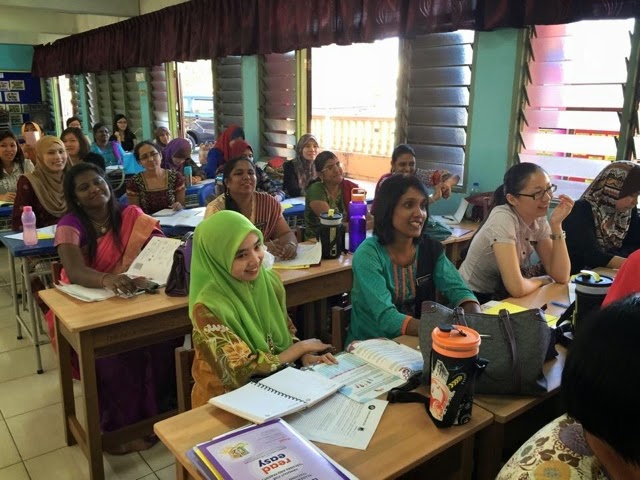Usually we would recommend a one-day programme for teachers who are not familiar with phonics. But today we have only 3 hours. Well 3 hours is quite good for an introductory phonics course. I hope we did justice to the 3 hours.
Greetings from Encik Othman, co-author Readeasy Phonics and PhonicsConsultant for KSSR ENGLISH Year 1 and 2 textbooks.
Taking turns Introducing each other. Pn Nik likes budu duriye, Encik Othman loves cucok badak.
We talked about SYNTHETIC PHONICS. Both Readeasy phonics and KSSR Phonics are written based on synthetic phonics.
What is Synthetic Phonics?
Synthetic phonics is a method of teaching reading which first teaches the smallest speech sounds ( phonemes ) and then builds up to blending these sounds together to achieve full pronunciation of words.
A very important point mentioned by Encik Othman is for teachers NOT to use letter names when teaching.
In Malaysia, before 2011, many of us, were taught to read in English by SPELL AND SAY method. In other words, we were actually NEVER taught to read. All we did was say the name of the letters in the word and 'read' it the way our teacher said it.
But not anymore. Since 2011 ( KSSR ENGLISH ) teachers are teaching pupils to DECODE WORDS by BLENDING sounds. Teachers are also teaching pupils to spell by SEGMENTING sounds.
We also reminded teachers that they are required by the Ministry of Education to use the British Received Pronunciation when teaching. Bukan saja kami nak mengada - ngada ya.
We had FUN checking out pronunciations of some common every day words.
" Siapa ajar sebut WEDNESDAY gitu?"
Yes! Let's get back on the right track then!
First things first. Practising to say all the 44 speech sounds in English.
Finally we shared some basic teaching steps with all the teachers.
Too bad there are no pictures.
Here are some links that might help new teachers introduce sounds and teach reading through blending:
http://readeasyteachersclub.blogspot.com/2010/12/eng-kssr-year-1-teaching-phonics-2.html
http://readeasyteachersclub.blogspot.com/2010/12/eng-kssr-year-1-teaching-phonics-3.html
Remember to
1. Frequently REVISE sounds that have been taught.
2. Keep showing the blending process using cards to train pupils to read by blending all the sounds.








No comments:
Post a Comment